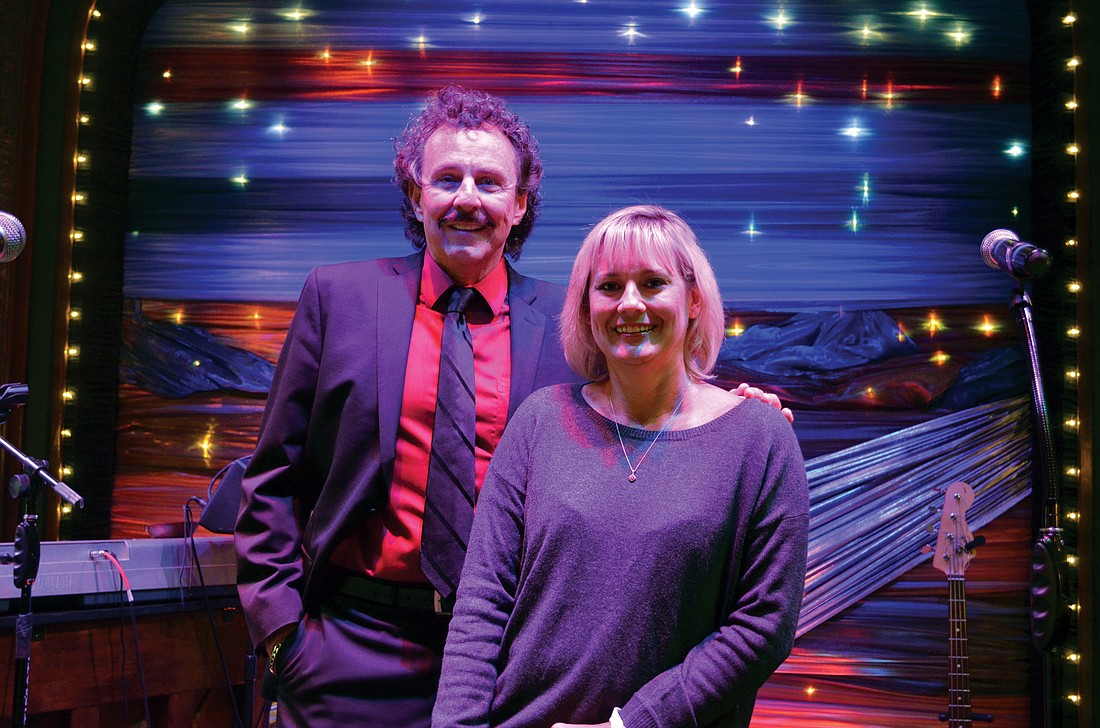- April 17, 2024
-
-
Loading

Loading

The stage, if one can call it that, is 10 by 12 feet in size. Instruments such as a piano, keyboard, mandolin, and electric and bass guitars crowd the small stage; what little space remains is filled with microphone stands and amplifiers. Aglow with a purple light, the stage is wrapped by a tightly packed room that can seat 100 people at tables draped in white tablecloths.
Unlike its sister stages at Florida Studio Theatre, the Goldstein Cabaret doesn’t house musicals or plays. It’s the home, as its name suggests, of the cabaret, a fusion between two theatrical forms.
Richard and Rebecca Hopkins, FST’s artistic director and managing director, respectively, have created and produced more than 100 unique cabarets since starting the cabaret space in 1996. The couple is a smaller scale Brill Building duo, constantly thinking and ruminating on the next idea or song for their cabaret.
“There are probably 10 shows we’re currently working on and planning at any given moment,” says Richard Hopkins. “It takes five or six months to develop these shows, and we’re constantly trying to develop new forms to do in the cabaret each year.”
In Sarasota, a town bursting with artistic opportunities, where does cabaret fall in the theatrical spectrum? Cabaret is a combination of the popular musical and formal play.
In addition, the cabaret stage has no walls or curtain, inviting the audience into the action.
“What separates the cabaret apart from a regular theater experience is that corporeal environment that you’re in with the audience,” says Rebecca Hopkins. “The audience is a part of the show. The actors onstage are taking on personas, but they’re still themselves, so there is an immediate connection.”
However, in the United States, the notion of cabaret has been expressed in a variety of controversial ways that have limited it from breaking into the mainstream. Imported from the Parisian nightclubs and small theaters at the turn of the 20th century, France’s underground theatrical movement was stolen as a guise for strip clubs, speakeasies during Prohibition and maudlin burlesque and minstrel shows. Today, America’s metropolitan cabaret scene is a chanteuse and a microphone according to Richard Hopkins, with one singer/performer striding through a collection of pop music standards. At FST, the Hopkinses have crafted a program that expands that solo format into an ensemble effort that presents a narrative not told through characters and imaginary worlds but through pre-existing songs.
 “American Pie” is the current production residing in the Goldstein Cabaret. Running through April 23, the show depicts America’s musical response to the rock ’n’ roll British invasion of the mid-1960s. Actors perform songs from artists such as Bob Dylan, Simon & Garfunkel, Carole King, Neil Diamond and Billy Joel during the show, forming a musical narrative of that time in American culture.
“American Pie” is the current production residing in the Goldstein Cabaret. Running through April 23, the show depicts America’s musical response to the rock ’n’ roll British invasion of the mid-1960s. Actors perform songs from artists such as Bob Dylan, Simon & Garfunkel, Carole King, Neil Diamond and Billy Joel during the show, forming a musical narrative of that time in American culture.
“As opposed to theater and a concert, it’s a kind of story through song by involving the audience in a journey going from point A to point B,” says Joe Casey, one of the five actors in “American Pie.” “It’s not just a bunch of songs strung together.”
And unlike the Broadway musical, which structures a narrative via a conscious selection of songs, the cabaret artists and actors play all of the instruments and interact with the audience.
“Cabaret is great because it has forced me to interact,” says Ben Mackel, another actor in “American Pie.” “I’ve always found comfort in that fourth wall, but now I’ve opened up to a new world of performing and engaging with the audience.”
The Hopkinses are expanding and producing cabaret productions at a rapid rate to make it commonplace and just as mainstream as FST’s other traditional dramatic fare. And it’s working. After almost 20 years in operation with three to nine shows per year, the cabaret’s subscription rate has reached approximately 12,000 subscribers, almost rivaling the subscription statistics of FST’s main stage season.
The Hopkinses are always looking for new ideas and inspiration in their current projects; each show runs for months at a time, averaging about 140 performances.
“Each show opens a door to a new idea for me,” says Rebecca Hopkins. “Last year we did a show titled ‘Poems, Prayers and Promises’ that was centered around John Denver and his contemporaries that opened the door to the music of ‘American Pie.’”
Richard Hopkins narrows down the allure and identity of the cabaret to his three i’s: intimacy, intimacy and intimacy.
“I think that a simple definition of cabaret is that it’s small or miniature theater,” says Richard Hopkins. “The other big one is corporeal. It’s never pretending to be something other than what it is. There’s a real grittiness to it.”